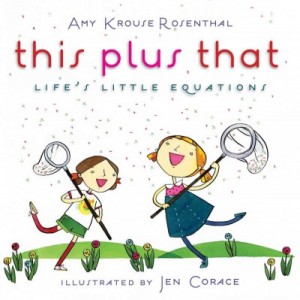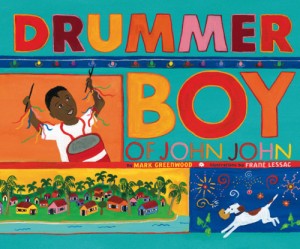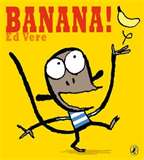Go Out and Play!
 Go Out and Play! Favorite Outdoor Games from KaBOOM! is like a chocolate-covered peanut butter cup: it combines two good things to make something wonderful, and it is something I cannot resist.
Go Out and Play! Favorite Outdoor Games from KaBOOM! is like a chocolate-covered peanut butter cup: it combines two good things to make something wonderful, and it is something I cannot resist.
The peanut-butter-part: Go Out and Play! is a nonfiction book, so sharing it with your students hits that Range of Reading Common Core Standard. Use the the table of contents (nice informational text feature) to help you choose from the dozens of games listed. Use the key at the bottom of each page (another nice informational text feature) to see how many players you’ll need, the recommended age group, how large an area you’ll need, and what, if any, materials you’ll need. Each game has one short page of information explaining how it is played. To build informational reading comprehension, give each student or group of students a page from the book to read. Each group can teach the class how to play that game. (Key Ideas and Details? Check!)
The chocolate part: Go Out and Play! will make your students want to go out and play. So yes it’s an informational book for teaching reading skills, but it’s all about games and playing outside – woohoo! Physical Education teachers will want to keep a copy all to themselves, but get one for your classroom, too, so when your students (or you) need a brain break you can grab this book and play.
When I saw that the author of this book is “KaBOOM!”, I did a little research. “KaBOOM! is a national non-profit dedicated to saving play for America’s children. Our mission is to create great playspaces through the participation and leadership of communities. Ultimately, we envision a place to play within walking distance of every child in America.” Now I like the book even more.
So, choose a game from Go Out and Play! Read how to play the game to or with your students. Then (at the risk of sounding like my mother) go out and play!
For more information about KaBOOM! and its mission to encourage outdoor play, please visit: kaboom.org.
Read MoreThis Plus That: Life’s Little Equations
 Not only is this week’s picture book a fun way to teach some of the Common Core State Standards in Reading, it is also the best inspiration for your “welcome back to school” classroom bulletin board.
Not only is this week’s picture book a fun way to teach some of the Common Core State Standards in Reading, it is also the best inspiration for your “welcome back to school” classroom bulletin board.
This Plus That: Life’s Little Equations written by Amy Krouse Rosenthal and illustrated by Jen Corace is sheer brilliance. It starts with:
1 + 1 = us
I love it! Not only will your students know how to read math symbols after sharing this book, but they’ll look at math much more creatively.
Smile + wave = hello
Smile + ocean wave = beach
Some are compare and contrast (I love what does and does not equal a sincere apology!), some are stand-alone sentences. Most are addition, but other math ideas come into play as well:
cozy + smell of pancakes – alarm clock = weekend
This would be fun to pair with 1 + 1 = 5 by David La Rochelle and Brenda Sexton if you’d like to hit Integrating Knowledge & Ideas, but all on its own This Plus That teaches Print Concepts and works beautifully to build Fluency.
After you share This Plus That, brainstorm and write equations with your students. In the book:
leaves + hot soup = fall
What things add up to fall for your students? And I’d love to make a welcoming bulletin board with:
1 + 1 = us and Joe + Gabriel + Julia + Matt…. = our class
This Plus That + your students = a whole new way of writing with math symbols!
For more information about the author, please visit whoisamy.com.
For more information about the illustrator, please visit jencorace.com.
Read More
Drummer Boy of John John
 Maybe it’s the vibrant art or maybe it’s the tropical setting of Trinidad, but on this snowy March day, I am in love with Drummer Boy of John John by Mark Greenwood with illustrations by Frane Lessac. Knowing that it’s a biography (so it hits the Common Core standard of Range of Reading) that incorporates music and art makes me love it even more.
Maybe it’s the vibrant art or maybe it’s the tropical setting of Trinidad, but on this snowy March day, I am in love with Drummer Boy of John John by Mark Greenwood with illustrations by Frane Lessac. Knowing that it’s a biography (so it hits the Common Core standard of Range of Reading) that incorporates music and art makes me love it even more.
It’s almost time for Carnival and everyone in Winston’s town is getting ready to celebrate with calypso music. Winston wishes he were in a band, because the best band in the parade will get free rotis from the Roti King. (Is your Craft and Structure Common Core Standard alarm ringing? Lots of interesting word choices in this book!) But Winston has no gourds full of seeds that go “shoush-shap/ shukka-shac” and no bamboo to pound on the ground with a “click clack/ rappa-tap” (Check Print Concepts off on your Common Core score card). When Winston throws his mango pit into the junkyard, he hears a “pong ping pang” as the pit hits old metal. Winston makes his own instrument from the dented metal containers – the first steel drum. Winston’s friends hear this music and form a junkyard band. They paint pots, pans, tins, and cans rainbow colors and experiment with the dents and bumps in the metal to make different pitches. Winston’s band is crowned the best band in the Carnival parade, so they all feast on rotis and mango lemonade.
This book has so many tie-ins for art, music, and social studies. (I wish I’d found it a month ago, so I could’ve used it for Carnival/Mardi Gras, but it’s a fun lesson any time of year.) Students can use recycled cans, jars, bottles and containers to make their own instruments. Paint them in the tropical rainbow colors Lessac used in her art. Play a clip of steel drum music for students (you can get cd’s from your local library or use this Youtube clip: Steel Drums in Trinidad and Tobago. Bring in mangos for students to taste after they try dancing under the limbo pole like the Roti King does. Use your recycled instruments to play a “listen and repeat” rhythm game to build listening skills. Winston Simon began with junk from the junkyard and ended up touring London and Paris with the Trinidad All Stars Percussion Orchestra. Who knows where tin cans and this inspirational book might take your students?
For more information about the author, visit: markgreenwood.com.au.
For more information about the illustrator, visit: franelessac.com
Read More
Banana!
 Want a book that every kid in your class can read with expression and enjoyment? Try Ed Vere’s nearly wordless picture book, Banana! I love using wordless and nearly wordless books with young readers. (If you want the myriad of reasons why wordless books are great for building narrative skills, fluency, top-down processing, etc., check out this article by the Center for the Improvement of Early Reading Achievement or this one from Education Week.) The facial expressions on the two monkeys are so engaging, and the text is limited to two words: banana and please with either question marks or exclamation points. As you read, point out how the exclamation mark and question mark change the way we read the words. (Print Concepts mini-lesson? Check!)
Want a book that every kid in your class can read with expression and enjoyment? Try Ed Vere’s nearly wordless picture book, Banana! I love using wordless and nearly wordless books with young readers. (If you want the myriad of reasons why wordless books are great for building narrative skills, fluency, top-down processing, etc., check out this article by the Center for the Improvement of Early Reading Achievement or this one from Education Week.) The facial expressions on the two monkeys are so engaging, and the text is limited to two words: banana and please with either question marks or exclamation points. As you read, point out how the exclamation mark and question mark change the way we read the words. (Print Concepts mini-lesson? Check!)
Banana! is perfect for young readers’ theater. After reading the book to your students, split them into pairs. The kids can make their own monkey masks or hats or puppets. Give students time to practice their lines (nailing that Common Core State Standard of Fluency). Then, kids take turns performing for the class, reading their lines as you hold up the book and turn the pages.
You can make a silly spin-off book called “Apple!” Take photos of two teachers arguing over who gets to eat the apple and lay them out like Ed Vere’s pages. You can make lots of little class books like this if you have a digital camera – let your students be the stars of the book, arguing over and eventually sharing an orange, or a pencil, etc. Your students will go, well, bananas for this book!
Read More






